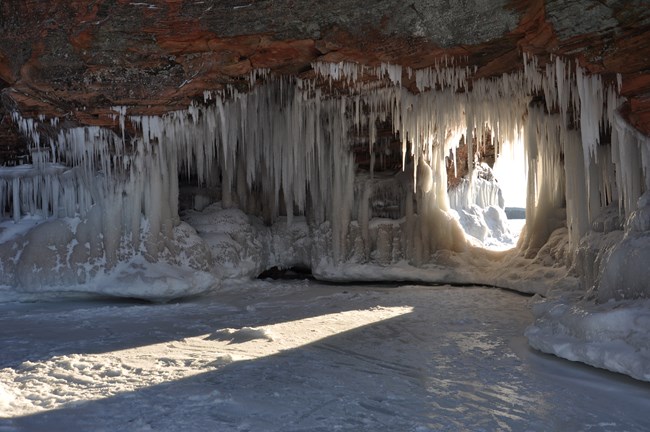
NPS Photo Ice Caves Status: ClosedThe ice caves are currently inaccessible due to non-existent or unstable ice conditions. The last time conditions allowed access to the ice caves was 2015. Winter Activities When Ice Caves Are InaccessibleFor winter activities in the area, visit the Bayfield Chamber & Visitor Bureau winter recreation page. About the Ice CavesThe ice caves are rare winter formations that form along the cliffs and sea caves of Apostle Islands National Lakeshore near Meyers Beach. As Lake Superior freezes, waves splashing against the rock and water seeping between sandstone layers form sculptures of ice. When Will the Ice Caves Open?The short answer is very rarely. 
NPS How Rare is Rare?The last time stable lake ice allowed access to the ice caves was for a brief nine-day period in 2015. What Are the Right Conditions?To safely walk across the miles of Lake Superior's frozen surface to reach the ice caves, several conditions must align.


Left image
Right image


Left image
Right image
Lake Ice is UnpredictableThe webcam can be misleading. Webcam Comparison Showing Ice Shelf Breakup in Less Than 12 Hours 

Top image
Bottom image
How Will I Know if the Ice Caves are Accessible?Park staff will update this page, our Facebook page, and the ice line in the rare event that the ice caves are accessible to visitors.
NPS staff monitor ice conditions on an ongoing basis. Note that NPS staff only provide updates when lake conditions allow safe access. If conditions haven’t been updated recently, it’s an indication that conditions haven’t changed and remain unfavorable for ice cave access. 
NPS Photo Winter Activities When Ice Caves Are InaccessibleEven when the Ice Caves are inaccessible, there are many winter activities to enjoy in the Apostle Islands National Lakeshore and surrounding communities.
Visit the Winter Activities page on the Bayfield Chamber & Visitor Bureau for activities in the area. 
NPS 
NPS / A. Hernandez |
Last updated: January 21, 2025

